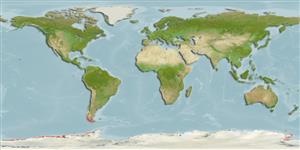Common names from other countries
Classification / Names / Names
Nomes comuns | Sinônimos | Catalog of Fishes (gen., sp.) | ITIS | CoL | WoRMS
Environment: milieu / climate zone / depth range / distribution range
Ecologia
; intervalo de profundidade 10 - 30 m (Ref. 87801). Subtropical
Antarctic Pacific and Southeast Pacific: Antarctica and Chile. Subtropical to polar.
Length at first maturity / Tamanho / Peso / Idade
Maturity: Lm ? range ? - ? cm
This species is usually found epizoic on other hydroids, e.g. Symplectoscyphus sp. at depths of 10 to 30 m (Ref. 87801).
Life cycle and mating behavior
Maturidade | Reprodução | Desova | Ovos | Fecundidade | Larvas
Members of the order Anthoathecata are mostly colonial A-form hydroids. Life cycle: The zygote develops into planula inside the gonophore and is later released as an actinula which metamorphoses into polyp stage.
Häussermann, V. and G. Försterra. 2009. (Ref. 87801)
Status na Lista Vermelha da IUCN (Ref. 130435)
Status no CITES (Ref. 108899)
Not Evaluated
Not Evaluated
Perigo para os humanos
Harmless
Uso pelos humanos
| FishSource |
Ferramentas
Mais informação
Nomes comunsSinônimosPredadoresReproduçãoMaturidadeDesovaFecundidadeOvosDesenvolvimento dos ovos
Idade/Tamanho
Crescimento
Comprimento-peso
Comprimento-comprimento
Morfologia
Larvas
Abundância
Fontes da internet
Estimates based on models
Preferred temperature
(Ref.
115969): -1.8 - -1.2, mean -1.8 (based on 28 cells).
